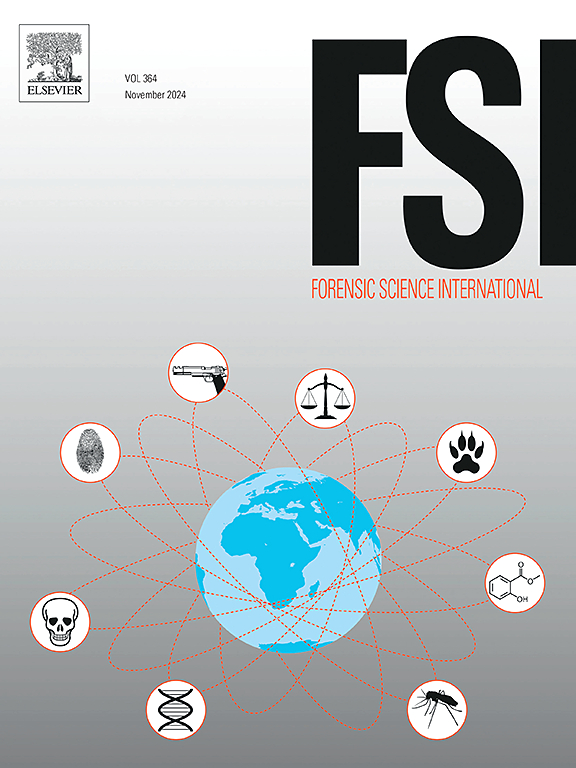13C/12C、18O/16O和2H/1H同位素比值的k -均值聚类分析用于醇源鉴定
IF 2.2
3区 医学
Q1 MEDICINE, LEGAL
引用次数: 0
摘要
由于多种原因,如代谢、扩散、收集污染、储存损失和分解,对乙醇消耗使用单一的定性和定量测试有时不能反映事件开始时的客观事实。稳定的同位素特征,因为它们是物质本身的自然属性,有能力描述物质的起源,因此有可能直接追踪乙醇。前人的研究表明,将δ13C值的测量与似然比的计算相结合,可以在一定程度上实现乙醇来源的判别。本研究采用气相色谱-同位素比值质谱法分析了99个酒精消耗样品(A组)、77个污染样品(B组)和14个分解样品(C组)。我们获得了所有三种样本类型的δ13C值、δ18O值和δ2H值,并通过似然比计算或k均值聚类分析- roc曲线方法对数据进行分析,并将其与5个真实样本进行比较,以确定它们是否来自饮酒。似然比法的准确度为80 %,k-均值聚类分析- roc曲线系统的准确度为100 %。这些发现表明,增加数据的维数可以提高似然率方法的准确性,并且k-均值聚类分析- roc曲线系统能够很好地区分血液样本中的乙醇是否来自饮酒。本文章由计算机程序翻译,如有差异,请以英文原文为准。
K-means clustering analysis of 13C/12C, 18O/16O and 2H/1H isotope ratios for identification of alcohol origin
Using a single qualitative and quantitative test for ethanol consumption sometimes fails to reflect the objective facts at the beginning of the incident for a variety of reasons, such as metabolism, diffusion, collection contamination, storage losses, and decomposition. Stable isotope signatures, because they are natural properties of the substance itself, have the ability to describe the origin of the substance and therefore have the potential to directly trace ethanol. Previous studies have shown that discrimination of ethanol origins can be achieved to a certain extent by combining the measurement of δ13C values with the calculation of likelihood ratios. In this study, we analyzed 99 alcohol consumption samples (group A), 77 contamination samples (group B), and 14 decomposition samples (group C) by a gas chromatography-isotope ratio mass spectrometry method. We obtained δ13C values, δ18O values, and δ2H values for all three sample types and analyzed the data by a likelihood ratio calculation or a k-means clustering analysis–ROC curve method and compared them to 5 authentic samples to determine whether they were derived from alcohol consumption. The accuracy of the likelihood ratio method was 80 %, and the accuracy of the k-means cluster analysis–ROC curve system was 100 %. These findings demonstrated that increasing the dimensionality of the data can improve the accuracy of the likelihood rate method and that the k-means cluster analysis–ROC curve system was able to distinguish with good accuracy whether ethanol in blood samples was derived from alcohol consumption.
求助全文
通过发布文献求助,成功后即可免费获取论文全文。
去求助
来源期刊

Forensic science international
医学-医学:法
CiteScore
5.00
自引率
9.10%
发文量
285
审稿时长
49 days
期刊介绍:
Forensic Science International is the flagship journal in the prestigious Forensic Science International family, publishing the most innovative, cutting-edge, and influential contributions across the forensic sciences. Fields include: forensic pathology and histochemistry, chemistry, biochemistry and toxicology, biology, serology, odontology, psychiatry, anthropology, digital forensics, the physical sciences, firearms, and document examination, as well as investigations of value to public health in its broadest sense, and the important marginal area where science and medicine interact with the law.
The journal publishes:
Case Reports
Commentaries
Letters to the Editor
Original Research Papers (Regular Papers)
Rapid Communications
Review Articles
Technical Notes.
 求助内容:
求助内容: 应助结果提醒方式:
应助结果提醒方式:


